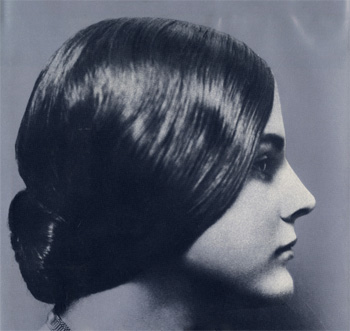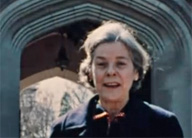Preface
By Ronald D. Patkus, Head of Special Collections and Adjunct Associate Professor of History

Mary McCarthy
Mary McCarthy and Vassar will be on display from March 16 to June 4, 2012 in the Vassar College Main Library.
2012 marks the 100th anniversary of the birth of Mary McCarthy, one of 20th century America's foremost writers and critics. She was born on June 21, 1912 in Seattle, Washington, the first child and only daughter of Roy Winfield and Therese ("Tess") Preston McCarthy. McCarthy and her three younger brothers (Kevin, Preston, and Sheridan) were orphaned in 1918, when both parents died in the influenza epidemic. For a time the children lived with their great-aunt and her husband, but then McCarthy moved back to Seattle to live with her maternal grandparents, while her brothers were sent to boarding school. This was a privileged environment, and McCarthy attended excellent schools. In 1929 she enrolled in the freshmen class at Vassar.
No one could have known it at the time, but McCarthy's arrival on campus was the beginning of a long relationship between her and the college, even though there were ups and downs at certain points. While a student, McCarthy was busy, making friends with classmates, writing for several undergraduate publications, and taking part in plays and other activities. Her academic responsibilities did not suffer, and she graduated Phi Beta Kappa in 1933. She moved to New York, was briefly married to Harold Johnsrud, and began to create a career as a critic and writer. Beginning in 1937 she helped revive the Partisan Review, and shortly thereafter she met and married the critic Edmund Wilson, with whom she had a son, Reuel. Her first book was published in 1942. McCarthy and Wilson divorced in 1945, and a year later she married Bowden Broadwater, who worked at the New Yorker. A prolific period of writing followed, and a string of novels and essays appeared. In 1961, after obtaining a divorce from Broadwater, McCarthy married James West, a diplomat. Her work as a writer and critic continued; through all of these stages of her working life, but especially from about 1950, McCarthy had regular interactions with the college. She wrote about it, used it as a background for a major novel, visited several times to read and lecture, and eventually chose it as the home for her personal papers.
This longstanding and interesting relationship between McCarthy and her alma mater is the subject of the centenary exhibition "Mary McCarthy and Vassar." Though a number of topics could have been presented, this one has several benefits. Because of the nature of the relationship, the theme allows us to explore a long span of McCarthy's life, from the time she was a teenager, until her last years. McCarthy's legacy is also part of the topic, as the college continued to note her accomplishments after her death in 1989. More important, this topic provides an opportunity to explore how Vassar influenced McCarthy, especially when she was a student, and also how the college was influenced by her, particularly in later years. We thus gain a fuller sense of both the writer and the institution. Structurally, half of the exhibition treats McCarthy's years as a student, while the other half deals with her interactions with the college in later years.
Of course the exhibition draws almost exclusively on the Mary McCarthy Papers at Vassar, one of the key holdings in the library's Virginia B. Smith Memorial Manuscript Collection. The first group of papers came to the college in 1985, and since then it has been followed by several large and significant additions. Vassar remains committed to building this collection and providing access to its contents. Today the collection serves as a window not only on the life and work of McCarthy, but also on 20th century intellectual and political circles in general. Indeed, researchers have used the materials to learn about a variety of subjects. When coupled with other holdings at Vassar, such as the college archives, and books in the Special Collections Library, a rich resource for study becomes available for students, faculty, and other researchers.
There are many people to thank for their contributions to the exhibition and its associated programming. First, I must acknowledge Margo Viscusi, co-trustee of the Mary McCarthy Literary Trust, for suggesting the topic at hand, and giving other helpful advice about the program when it was in its nascent stages. I am very grateful for Margo's help. Next, I must thank Meghan Daum '92, for her lucid essay in this publication, as well as her willingness to visit Vassar to talk about McCarthy and discuss writing with current students. Meghan's participation has given special attention to Vassar's extraordinary literary tradition. Library director Sabrina Pape provided substantial help in planning for the exhibition and its programming. Colleagues in the English Department and the Learning, Teaching and Research Center, especially Patricia Wallace, Susan Zlotnick, Ronald Sharp, and Matthew Schultz, worked with the library to develop its programming. Colleagues in the Communications Office, particularly Carolyn Guyer, Morgan Gange, Tamar Thibodeau, Emily Darrow, and George Laws, all applied their remarkable talents in their respective areas of expertise. Dixie Sheridan offered helpful insights and material for exhibition captions. Visual Resources Library Manager Sharyn Cadogen oversaw the production of images for both the publication and the website. Baynard Bailey of Academic Computing Services produced the exhibition video, which offers clips of Mary McCarthy at Vassar. Conservator Nelly Balloffet of Paper Star Associates helped prepare the materials for display in the exhibition cases. Student assistant Jenna Effenberger assisted in the gathering of materials and produced the exhibition checklist.
